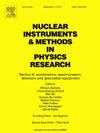Light concentrator design for the large array of imaging atmospheric Cherenkov Telescopes (LACT)
IF 1.5
3区 物理与天体物理
Q3 INSTRUMENTS & INSTRUMENTATION
Nuclear Instruments & Methods in Physics Research Section A-accelerators Spectrometers Detectors and Associated Equipment
Pub Date : 2025-05-01
DOI:10.1016/j.nima.2025.170545
引用次数: 0
Abstract
The light concentrator, as an important component of the optical detector of the imaging atmospheric Cherenkov telescopes is mainly used to collect and focus the Cherenkov light generated by the extensive air shower. In order to achieve higher angular resolution than the large high altitude air shower observatory (LHAASO), the Large Array of imaging atmospheric Cherenkov Telescope (LACT) project in LHAASO site is proposed in China. In this paper, we specifically focus on the research of the reflective square light concentrator for LACT based on the fundamental principles of the Winston cone, and then optimize it by Bézier functions. The light concentrator with an entrance size of 24.4 mm 24.4 mm and an exit size of 13 mm 13 mm has been designed. It exhibits an absolute cutoff angle of 37.02° and an effective cutoff angle of 28.85°, with a parallel light collection efficiency exceeding 90% when the incident angle 22°, meanwhile the inconsistency in collection efficiency at different positions in the field of view is less than 0.28%. Additionally, we summarized the research process and proposed a standardized process for light concentrator design.
大阵列成像大气切伦科夫望远镜(LACT)聚光器设计
光聚光器是成像大气切伦科夫望远镜光学探测器的重要组成部分,主要用于收集和聚焦大面积气淋产生的切伦科夫光。为了获得比大型高空空气阵雨观测站(LHAASO)更高的角度分辨率,中国提出了在LHAASO站点建设大型阵列成像大气切伦科夫望远镜(LACT)项目。本文基于温斯顿锥的基本原理,重点研究了用于LACT的反射式方形聚光器,并利用bsamizier函数对其进行了优化。设计了入口尺寸为24.4 mm × 24.4 mm,出口尺寸为13 mm × 13 mm的聚光器。绝对截止角为37.02°,有效截止角为28.85°,入射角为<;22°时平行光收集效率超过90%,视场内不同位置的收集效率不一致性小于0.28%。此外,我们总结了研究过程,并提出了一个标准化的光聚光器设计流程。
本文章由计算机程序翻译,如有差异,请以英文原文为准。
求助全文
约1分钟内获得全文
求助全文
来源期刊
CiteScore
3.20
自引率
21.40%
发文量
787
审稿时长
1 months
期刊介绍:
Section A of Nuclear Instruments and Methods in Physics Research publishes papers on design, manufacturing and performance of scientific instruments with an emphasis on large scale facilities. This includes the development of particle accelerators, ion sources, beam transport systems and target arrangements as well as the use of secondary phenomena such as synchrotron radiation and free electron lasers. It also includes all types of instrumentation for the detection and spectrometry of radiations from high energy processes and nuclear decays, as well as instrumentation for experiments at nuclear reactors. Specialized electronics for nuclear and other types of spectrometry as well as computerization of measurements and control systems in this area also find their place in the A section.
Theoretical as well as experimental papers are accepted.

 求助内容:
求助内容: 应助结果提醒方式:
应助结果提醒方式:


